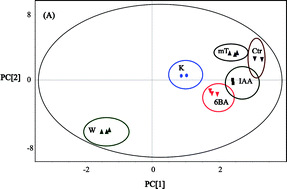Metabolomics analysis of major metabolites in medicinal herbs
Abstract
A metabolomics approach with a platform consisting of

* Corresponding authors
a
Natural Sciences and Science Education Academic Group, Nanyang Technological University, 1 Nanyang Walk, Singapore, Singapore
E-mail:
sweengin.tan@nie.edu.sg, chinchye_teo@yahoo.com.sg
Fax: (+65) 6896 9414
b Institute of Advanced Studies, Nanyang Technological University, Nanyang Executive Centre #02-18, 60 Nanyang View, Singapore, Singapore
c Singapore University of Technology and Design, 20 Dover Road, Singapore, Singapore
A metabolomics approach with a platform consisting of

 Please wait while we load your content...
Something went wrong. Try again?
Please wait while we load your content...
Something went wrong. Try again?
C. C. Teo, S. N. Tan, J. W. Hong Yong, T. Ra, P. Liew and L. Ge, Anal. Methods, 2011, 3, 2898 DOI: 10.1039/C1AY05334E
To request permission to reproduce material from this article, please go to the Copyright Clearance Center request page.
If you are an author contributing to an RSC publication, you do not need to request permission provided correct acknowledgement is given.
If you are the author of this article, you do not need to request permission to reproduce figures and diagrams provided correct acknowledgement is given. If you want to reproduce the whole article in a third-party publication (excluding your thesis/dissertation for which permission is not required) please go to the Copyright Clearance Center request page.
Read more about how to correctly acknowledge RSC content.
 Fetching data from CrossRef.
Fetching data from CrossRef.
This may take some time to load.
Loading related content
